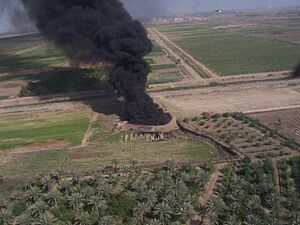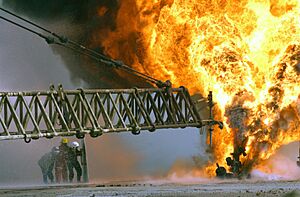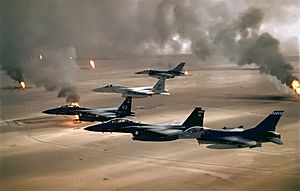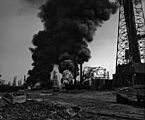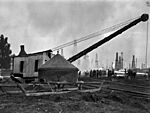Oil well fire facts for kids
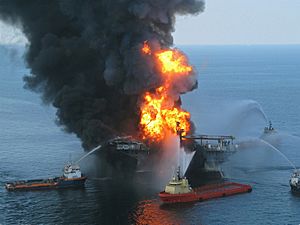
Oil well fires happen when oil or gas wells catch fire and burn. These fires can start because of accidents, arson (when someone purposely sets a fire), or even natural events like lightning. They can be small, like a burning oil spill, or very big, with huge flames shooting out like a geyser from wells with high pressure. Often, a well fire starts because of a high-pressure blowout during drilling. A blowout is when oil or gas suddenly bursts out of a well in an uncontrolled way.
Contents
How to Put Out Oil Well Fires
Putting out oil well fires is much harder than putting out regular fires. This is because there's a huge supply of fuel (oil or gas) feeding the flames. When fighting a fire at the top of a well (called the wellhead), firefighters often use high explosives like dynamite. The explosion creates a powerful shockwave. This wave pushes the burning fuel and the air (oxygen) away from the well. It's similar to how you might blow out a candle! When the flame is gone, the oil can still spill out, but it won't catch fire again.
After the fire is blown out, the wellhead needs to be sealed to stop the oil flow. During this time, there's still a lot of fuel and oxygen around. Any spark or heat could cause an even worse fire. So, firefighters use special tools made of brass or bronze, or tools coated in paraffin wax. These tools don't create sparks, which keeps everyone safe.
The job of fighting oil well fires was largely started by Myron M. Kinley. Later, his assistant, Red Adair, became the most famous oil well firefighter.
Techniques for Extinguishing Fires
There are several ways to put out oil well fires. The method used depends on the available tools and the type of fire. Today, with new technology, many straightforward well fires can be capped (sealed) even while they are still burning.
Here are some common techniques:
- Using Lots of Water: Many fires, especially during the 1991 Kuwait oil fires, were put out simply by spraying huge amounts of sea water. Powerful hoses aimed water at the base of the fire.
- Water Mist from Jet Engines: Sometimes, a gas turbine (like a jet engine) is used to spray a fine mist of water at the fire's base. This method was very helpful for tough fires in Kuwait. Hungarian teams used vehicles called "Big Wind" with MiG-21 jet engines mounted on tanks. These machines sprayed large amounts of water behind the engine's exhaust.
- Blowing Out with Explosives: This is one of the oldest and still widely used methods. Dynamite is placed in 55 gallon drums, surrounded by chemicals that stop fire, and then wrapped in insulating material. A crane carefully moves the drum close to the wellhead. The explosion then "blows out" the fire by separating the flame from its fuel and oxygen. This method was first used in California in 1913.
- Dry Chemicals: For smaller well fires, special dry chemicals, like "Purple K," can be used.
- Raising the Flame: A tall metal pipe, about 30 to 40 feet high, is placed over the wellhead. This makes the flame burn higher above the ground. Then, liquid nitrogen or water is pumped into the bottom of the pipe. This reduces the oxygen supply and puts out the fire.
- Special Machines: The LeRoy Corporation built machines with an arm that could lower a cap over a burning oil pipe. This would put out the flames. These machines were called Shadrach, Meshach, and Abednego, named after characters from the Bible who survived a fiery furnace. The walls of these machines were hollow, allowing water to circulate and keep the control room cool inside.
- Drilling Relief Wells: Sometimes, new wells called "relief wells" are drilled into the ground near the burning well. These wells can help redirect some of the oil, making the fire smaller. Most relief wells are used to pump heavy mud and cement deep into the wild well to seal it. The first relief wells were drilled in Texas in the 1930s.
- Underground Nuclear Explosions: In the Soviet Union, underground nuclear explosions were sometimes used to stop well fires. The intense heat from the explosion would melt the rock around the well, sealing the hole and stopping the fire.
Impact of Oil Well Fires
Oil well fires can cause huge losses of barrels of crude oil every day. Besides the economic cost, they also create serious environmental problems. Large amounts of smoke and unburnt oil fall back to Earth. For example, the Kuwait oil fires in 1991 caused massive economic and environmental damage.
The smoke from burning crude oil contains many harmful chemicals. These include sulfur dioxide, carbon monoxide, soot, and other complex chemicals.
-
Two wells burning in Santa Fe Springs, California, 1928.
-
A steel cap used to seal a burning oil well in Santa Fe Springs, California, 1928.
Famous Oil Well Fires
- Piper Alpha: An oil rig that caught fire.
- Kuwaiti oil fires: Many oil wells burned in Kuwait in 1991.
- Deepwater Horizon explosion: A major oil rig explosion and fire.
- Tengiz Field explosion: A large explosion at an oil field.
See also
- Coal seam fire
- Derweze


